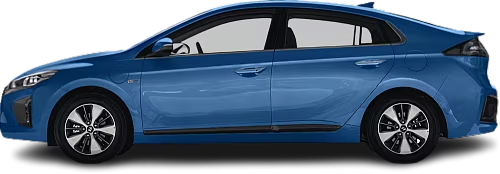Global EV Comparison: Hyundai Ioniq Electric Gen 1 vs Tesla Model 3 Standard Range
Struggling to Decide? Let AI Help!
Your AI Summary Is Ready!
General Info
Since both vehicles have been discontinued, they are now only available on the used car market. You can get the Hyundai Ioniq Electric Gen 1 (2016-2019) for as low as €10990, while the Tesla Model 3 Standard Range (2019-2020) begins at €18790.
The Hyundai Ioniq Electric Gen 1 (2016-2019) is a Liftback, whereas the Tesla Model 3 Standard Range (2019-2020) is a Sedan.
| Property | Hyundai Ioniq Electric Gen 1 | Tesla Model 3 Standard Range |
|---|---|---|
| Years of Production | 2016-2019 | 2019-2020 |
| Current Status | Discontinued | Discontinued |
| Country of Manufacture | South Korea | China, Germany, USA |
| Body Style | Liftback | Sedan |
| Market Availability | EU, USA | EU, USA |
| Price Europe (Used) | €10990 | €18790 |
| GCC Score | 4.8 | 6.1 |
Range and Efficiency
While the Tesla Model 3 Standard Range (2019-2020) offers a longer real-world range and a bigger battery, it is less energy-efficient than the Hyundai Ioniq Electric Gen 1 (2016-2019).
| Property | Hyundai Ioniq Electric Gen 1 | Tesla Model 3 Standard Range |
|---|---|---|
| Range (EPA) | 200 km | 354 km |
| Range (GCC) | 200 km | 336 km |
| Battery Capacity (Nominal) | 30.5 kWh | 60 kWh |
| Battery Capacity (Usable) | 28 kWh | 57.5 kWh |
| Efficiency per 100 km | 14 kWh/100 km | 17.1 kWh/100 km |
| Efficiency per kWh | 7.14 km/kWh | 5.84 km/kWh |
| Range and Efficiency Score | 6.2 | 6.3 |
Charging
Both vehicles utilize a standard 400-volt architecture.
The Tesla Model 3 Standard Range (2019-2020) offers faster charging speeds at DC stations, reaching up to 170 kW, while the Hyundai Ioniq Electric Gen 1 (2016-2019) maxes out at 69 kW.
The Tesla Model 3 Standard Range (2019-2020) features a more powerful on-board charger, supporting a maximum AC charging power of 11 kW, whereas the Hyundai Ioniq Electric Gen 1 (2016-2019) is limited to 6.6 kW.
| Property | Hyundai Ioniq Electric Gen 1 | Tesla Model 3 Standard Range |
|---|---|---|
| Max Charging Power (AC) | 6.6 kW | 11 kW |
| Max Charging Power (DC) | 69 kW | 170 kW |
| Architecture | 400 V | 400 V |
| Charge Port | CCS Type 2 | CCS Type 2 (Tesla) |
| Charging Score | 3.5 | 5.7 |
Performance
The Tesla Model 3 Standard Range (2019-2020) is rear-wheel drive, while the Hyundai Ioniq Electric Gen 1 (2016-2019) offers a front-wheel drive system.
The Tesla Model 3 Standard Range (2019-2020) boasts greater motor power and accelerates faster from 0 to 100 km/h.
| Property | Hyundai Ioniq Electric Gen 1 | Tesla Model 3 Standard Range |
|---|---|---|
| Drive Type | FWD | RWD |
| Motor Type | PMSM | PMSM |
| Motor Power (kW) | 88 kW | 208 kW |
| Motor Power (hp) | 118 hp | 279 hp |
| Motor Torque | 295 Nm | 420 Nm |
| 0-100 km/h | 9.9 s | 6.1 s |
| Top Speed | 165 km/h | 225 km/h |
| Performance Score | 2.8 | 5 |
Dimensions
The Tesla Model 3 Standard Range (2019-2020) is longer, but has a similar width and height to the Hyundai Ioniq Electric Gen 1 (2016-2019).
The Tesla Model 3 Standard Range (2019-2020) boasts a more extended wheelbase.
| Property | Hyundai Ioniq Electric Gen 1 | Tesla Model 3 Standard Range |
|---|---|---|
| Length | 4470 mm | 4695 mm |
| Width (with Mirrors) | 2045 mm | 2088 mm |
| Width (w/o Mirrors) | 1820 mm | 1850 mm |
| Height | 1450 mm | 1445 mm |
| Wheelbase | 2700 mm | 2875 mm |
Cargo and Towing
The Tesla Model 3 Standard Range (2019-2020) features a larger trunk, but the Hyundai Ioniq Electric Gen 1 (2016-2019) offers greater maximum cargo capacity when the rear seats are folded.
A frunk (front trunk) is available in the Tesla Model 3 Standard Range (2019-2020), but the Hyundai Ioniq Electric Gen 1 (2016-2019) doesn’t have one.
The Tesla Model 3 Standard Range (2019-2020) has a towing capacity of up to 1000 kg, whereas the Hyundai Ioniq Electric Gen 1 (2016-2019) is not officially rated for towing in the EU.
| Property | Hyundai Ioniq Electric Gen 1 | Tesla Model 3 Standard Range |
|---|---|---|
| Number of Seats | 5 | 5 |
| Curb Weight | 1495 kg | 1611 kg |
| Cargo Volume (Trunk) | 350 l | 561 l |
| Cargo Volume (Max) | 1410 l | 1235 l |
| Cargo Volume (Frunk) | - Cargo Volume (Frunk) | 88 l |
| Towing Capacity | - Towing Capacity | 1000 kg |
| Cargo and Towing Score | 4.1 | 5.1 |




